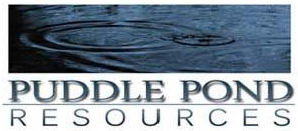- BY TiVaHostAdmin
- POSTED IN Heritage Gold and Silver Project, News
- WITH 0 COMMENTS
- PERMALINK
- STANDARD POST TYPE
Newfoundland based junior exploration and mining company, Puddle Pond Resources Inc. is pleased to report the successful completion of the first stage of exploratory drilling on the newly discovered Heritage, low sulphidation epithermal Gold – Silver Project. The drilling program was designed to test a 1,000 metre section of the pervasively gold – silver mineralized, spectacular epithermal alteration system uncovered along a 3.9 km long strike length during the 2012 trenching program (ref. press release October 31, 2012).
Five (5) angle holes totalling 498 metres of core drilled under trench locations along the 1,000 metre section all intersected the down dip extension of the surface mineralization. The program was designed to carry out upper tier, shallow drill testing of the mineralization down to a vertical depth of 60 metres (200 ft). Whereas the zone was consistently intersected in the shallow holes it was decided to drill one hole to test the zone to a deeper level. This hole also intersected the mineralization down to 133 metres (436 ft) vertically and thereby demonstrating the potential for significant down dip extension. (Epithermal systems typically extend to at least 300 metres below surface and can extend down to 1,000 metres vertically.) This deeper hole also intersected a thicker section, indicating the zone may be getting wider with depth.
The company notes “to achieve these results in the initial drill program is highly encouraging and not only confirms the down dip extension, but the continuity of the mineralized zone along strike”.
All drill core samples have been cut and shipped to Eastern Analytical Laboratories at Springdale, NL for analysis. Assay results are expected to be finalized by mid-March and will be released upon receipt.
The technical information was compiled by Victor A. French, P. Geo., Vice President of Exploration for Puddle Pond and a qualified person as defined by National Instrument 43-101.


